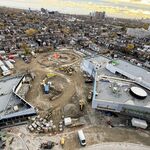rbt
Senior Member
It's kind of funny that the streetcars are sharing a ship with high-end BMWs and Rolls-Royces. Quite a juxtaposition.
Not really. Streetcars are probably one of the most expensive vehicles that an automotive company, like BMW (they make buses, do they make trams?), can mass produce.
Aircraft engines being one of the more expensive individual components.




